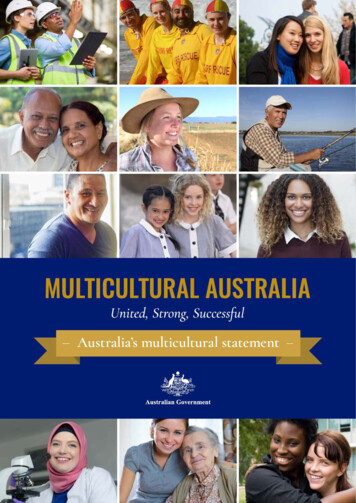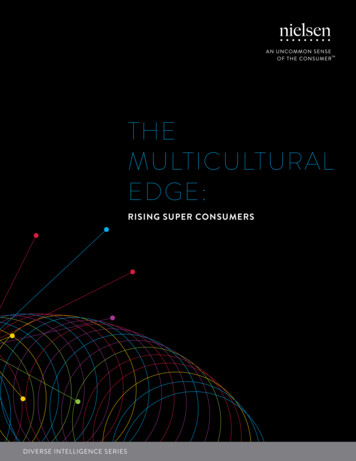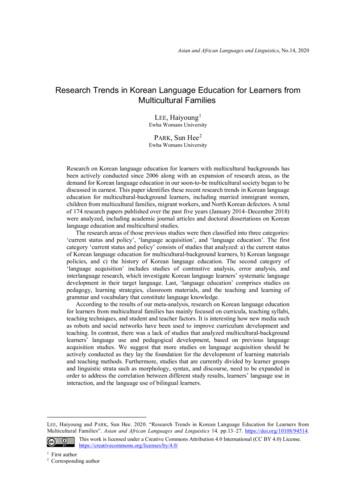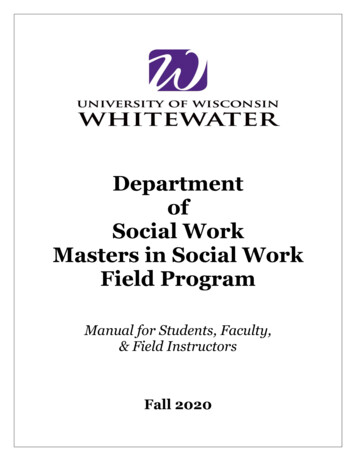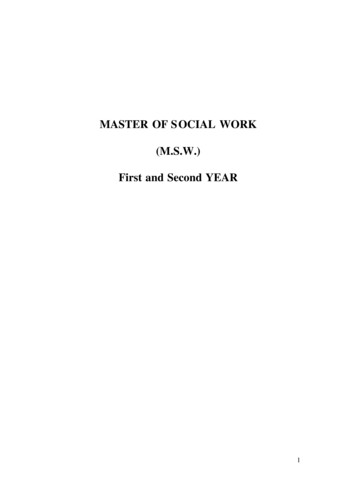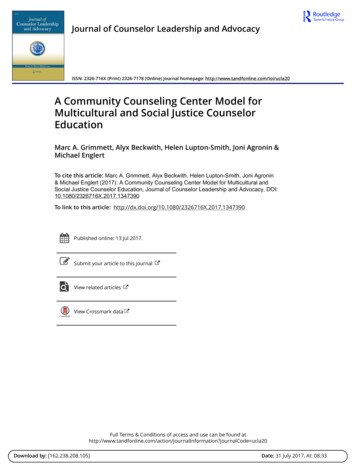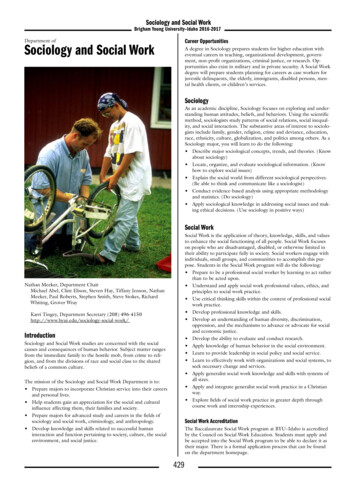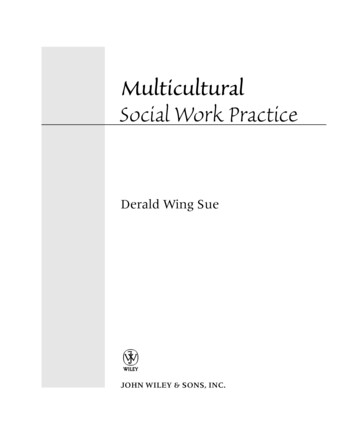
Transcription
MulticulturalSocial Work PracticeDerald Wing SueJOHN WILEY & SONS, INC.
MulticulturalSocial Work Practice
MulticulturalSocial Work PracticeDerald Wing SueJOHN WILEY & SONS, INC.
This book is printed on acid-free paper. oCopyright 2006 by John Wiley & Sons, Inc. All rights reserved.Published by John Wiley & Sons, Inc., Hoboken, New Jersey.Published simultaneously in Canada.No part of this publication may be reproduced, stored in a retrieval system, or transmitted inany form or by any means, electronic, mechanical, photocopying, recording, scanning, orotherwise, except as permitted under Section 107 or 108 of the 1976 United States CopyrightAct, without either the prior written permission of the Publisher, or authorization throughpayment of the appropriate per-copy fee to the Copyright Clearance Center, Inc., 222Rosewood Drive, Danvers, MA 01923, (978) 750-8400, fax (978) 646-8600, or on the web atwww.copyright.com. Requests to the Publisher for permission should be addressed to thePermissions Department, John Wiley & Sons, Inc., 111 River Street, Hoboken, NJ 07030, (201)748-6011, fax (201) 748-6008 or online at http://www.wiley.com/go/permissions.Limit of Liability/Disclaimer of Warranty: While the publisher and author have used their bestefforts in preparing this book, they make no representations or warranties with respect to theaccuracy or completeness of the contents of this book and specifically disclaim any impliedwarranties of merchantability or fitness for a particular purpose. No warranty may be createdor extended by sales representatives or written sales materials. The advice and strategiescontained herein may not be suitable for your situation. You should consult with a professionalwhere appropriate. Neither the publisher nor author shall be liable for any loss of profit or anyother commercial damages, including but not limited to special, incidental, consequential, orother damages.This publication is designed to provide accurate and authoritative information in regard to thesubject matter covered. It is sold with the understanding that the publisher is not engaged inrendering professional services. If legal, accounting, medical, psychological or any other expertassistance is required, the services of a competent professional person should be sought.Designations used by companies to distinguish their products are often claimed as trademarks.In all instances where John Wiley & Sons, Inc. is aware of a claim, the product names appear ininitial capital or all capital letters. Readers, however, should contact the appropriate companiesfor more complete information regarding trademarks and registration.For general information on our other products and services please contact our Customer CareDepartment within the U.S. at (800) 762-2974, outside the United States at (317) 572-3993 orfax (317) 572-4002.Wiley also publishes its books in a variety of electronic formats. Some content that appears inprint may not be available in electronic books. For more information about Wiley products,visit our web site at www.wiley.com.ISBN-13 978-0-471-66252-5ISBN-10 0-471-66252-6Printed in the United States of America10 9 8 7 6 5 4 3 2 1
CONTENTSForewordPrefacexiiixviiPart IThe Conceptual Dimensions of MulticulturalSocial Work Practice1Chapter 1Principles and Assumptions of MulticulturalSocial Work Practice3The Diversification of the United States andImplications for Social Work4The Graying of the Workforce and Society 4The Feminization of the Workforce and SocietyThe Changing Complexion of the Workforceand Society 65Cultural Diversity and the Challenge to Social Work7Theme One: Cultural Universality versusCultural Relativism 10Theme Two: The Emotional Consequences of “Raceand/or Differences”11Theme Three: The Inclusive or Exclusive Natureof Multiculturalism 12Theme Four: The Sociopolitical Nature of SocialWork Practice 13Theme Five: The Nature of Culturally Competent SocialWork Practice 14The Multiple Dimensions of Human ExistenceIndividual and Universal Biases in Social WorkWhat Is Multicultural Social Work Practice?151820v
viContentsChapter 2Becoming Culturally Competent in Social Work Practice23Defining Cultural Competence in Social Work PracticeThe Four Components of Cultural Competence2324Competency One: Becoming Aware of One’s Own Assumptions, Values, and Biasesabout Human Behavior 25Competency Two: Understanding the Worldview of CulturallyDiverse Clients 26Competency Three: Developing Appropriate Intervention Strategiesand Techniques 27Competency Four: Understanding Organizational and Institutional Forces thatEnhance or Negate Cultural Competence 28A Working Definition of Cultural CompetenceMultidimensional Model of Cultural Competence in Social Work2930Dimension I: Group-Specific Worldviews 32Dimension II: Components of Cultural Competence 32Dimension III: Foci of Social Work Interventions 37Implications for Social Work Practice38Part IIThe Political Dimensions of Social Work Practice41Chapter 3Understanding the Sociopolitical Implications of Oppression inSocial Work Practice43Effects of Historical and Current OppressionEthnocentric Monoculturalism4749Belief in Superiority 50Belief in the Inferiority of Others 50Power to Impose Standards 51Manifestation in Institutions 51The Invisible Veil 52Historical Manifestations of Ethnocentric MonoculturalismImpact of Ethnocentric Monoculturalism in Helping Relationships5355
ContentsCredibility and Attractiveness in Multicultural Social Work PracticeCredibility of Social Workervii5757Implications for Social Work Practice61Chapter 4Sociopolitical Dimensions of Worldviews63The Formation of WorldviewsValue Orientation Model of Worldviews6566Locus of Control 68Locus of Responsibility71Formation of Worldviews73Internal Locus of Control (IC)–Internal Locus of Responsibility (IR)74External Locus of Control (EC)–Internal Locus of Responsibility (IR)77External Locus of Control (EC)–External Locus of Responsibility (ER)78Internal Locus of Control (IC)–External Locus of Responsibility (ER)80Part IIIRacial/Cultural Identity Development: Social Work Implications85Chapter 5Racial/Cultural Minority Identity Development87Racial/Cultural Identity Development Models88Black Identity Development Models 89Other Racial/Ethnic Identity Development ModelsFeminist Identity Theory 9190A Working Racial/Cultural Identity Development Model92Conformity Stage 93Dissonance Stage 98Resistance and Immersion Stage 99Introspection Stage 101Integrative Awareness Stage 103Social Work Implications of the R/CID Model104
viiiContentsChapter 6White Racial Identity Development107What Does It Mean to Be White?10742-year-old White Business Man 10726-year-old White Female College Student 10865-year-old White Male Retired Construction Worker34-year-old White Female Stockbroker 10829-year-old Latina Administrative Assistant 10939-year-old Black Male Salesman 10921-year-old Chinese American Male College Student(majoring in ethnic studies) 110108The Invisible Whiteness of BeingUnderstanding the Dynamics of Whiteness110112Models of White Racial Identity DevelopmentThe Hardiman White Racial Identity Development ModelThe Helms White Racial Identity Model 117114115The Process of White Racial Identity Development: A Descriptive Model120Conformity Phase 122Dissonance Phase123Resistance and Immersion Phase 125Introspection Phase126Integrative Awareness Phase 127Implications for Social Work Practice127Part IVThe Practice Dimensions of Multicultural Social Work129Chapter 7Barriers to Effective Multicultural Clinical Practice131Generic Characteristics of Counseling/TherapySources of Conflict and Misinterpretation in Clinical Practice135138Culture-Bound Values 138Class-Bound Values 145Language Barriers 148
ContentsGeneralizations and Stereotypes: Some CautionsImplications for Social Work Practiceix149150Chapter 8Cultural Styles in Multicultural Intervention Strategies153Communication StylesNonverbal Communication155156Proxemics 157Kinesics 158Paralanguage 160High-/Low-Context Communication162Sociopolitical Facets of Nonverbal CommunicationNonverbals as Reflections of Bias 165Nonverbals as Triggers to Biases and Fears164167Differential Skills in Multicultural Social Work PracticeImplications for Social Work Practice170171Chapter 9Multicultural Family Counseling and Therapy173Family Systems Approaches and AssumptionsIssues in Working with Ethnic Minority Families179181Ethnic Minority Reality 181Conflicting Value Systems 182Biculturalism 182Ethnic Differences in Minority StatusEthnicity and Language 185Ethnicity and Social Class 186183Multicultural Family Social Work: A Conceptual Model187People-Nature Relationship 188Time Dimension 189Relational Dimension 191Activity Dimension 192Nature of People Dimension 194Implications for Social Work Practice195
xContentsChapter 10Non-Western and Indigenous Methods of Healing199Spirit Attacks: The Case of Vang Xiong199Symptoms and CauseShamanic Cure 200200The Legitimacy of Culture-Bound Syndromes: Nightmare Deaths and theHmong Sudden Death PhenomenonCausation and Spirit PossessionThe Shaman as Therapist: CommonalitiesA Case of Child Abuse?201203206207The Principles of Indigenous Healing211Holistic Outlook, Interconnectedness, and HarmonyBelief in Metaphysical Levels of Existence 216Spirituality in Life and the Cosmos 217213ConclusionsImplications for Social Work Practice220220Part VSystemic and Ecological Perspectives of Multicultural Social Work225Chapter 11Multicultural Organizational Change and Social Justice227Monocultural versus Multicultural Organizational Perspectives in Social Work229Lesson One: A failure to develop a balanced perspective between person focusand system focus can result in false attribution of the problem. 231Lesson Two: A failure to develop a balanced perspective between person focus andsystem focus can result in an ineffective and inaccurate treatment plan that ispotentially harmful toward the client. 232Lesson Three: When the client is the “organization” or a larger system and not an“individual,” it requires a major paradigm shift to attain a true understanding ofproblem and solution identification. 232Lesson Four: Organizations are microcosms of the wider society from which theyoriginate. As a result, they are likely to be reflections of the monoculturalvalues and practices of the larger culture. 233
ContentsxiLesson Five: Organizations are powerful entities that inevitably resist change andpossess within their arsenal many ways to force compliance in individuals. 233Lesson Six: When multicultural organizational development is required, alternativehelping roles that emphasize systems intervention must be part of the rolerepertoire of the social worker. 234Lesson Seven: Although remediation will always be needed, preventionis better. 234Models of Multicultural Organizational DevelopmentCulturally Competent Social Service AgenciesThe Social Justice Agenda of Multicultural Social WorkAntiracism as a Social Justice Agenda235238242245Principle One: Having Intimate and Close Contact with Others 246Principle Two: Cooperating Rather Than Competing 247Principle Three: Sharing Mutual Goals 248Principle Four: Exchanging Accurate Information 248Principle Five: Sharing an Equal Relationship 249Principle Six: Supporting Racial Equity by Leaders and Groupsin Authority 251Principle Seven: Feeling Connected and Experiencing a Strong Senseof Belonging 251Social Work Must Advocate for Social Change253Part VIProfiles in Culturally Competent Care for Diverse Populations255Chapter 12Profiles of Culturally Competent Care with African American,Asian American, and Native American Populations257African American Profile258Important Dimensions258Asian American ProfileImportant Dimensions264264Native American/American Indian ProfileImportant Dimensions270269
xiiContentsChapter 13Profiles of Culturally Competent Care with Biracial/Multiracial,Latino/Hispanic, and Immigrant/Refugee Populations277Biracial/Multiracial Profile277Important Dimensions277Latino/Hispanic American ProfileImportant Dimensions285Immigrants/Refugees ProfileImportant Dimensions284291292Chapter 14Profiles of Culturally Competent Care with Women, SexualMinorities, Elderly Persons, and Those with Disabilities299Women Profile299Important Dimensions299Sexual Minority ProfileImportant Dimensions306306Elderly Persons ProfileImportant Dimensions314315Persons with Disability ProfileImportant Dimensions323323References331Author Index353Subject Index359
FOREWORDDerald Wing Sue’s book Multicultural Social Work Practice reflectsthe most important underlying principles of social work. Theseprinciples have too often been hidden from view by the power dynamics of our society. These individualistic and materialistic dynamics makeit hard to think or operate in systemic ways that would allow us to betruly open to those who are culturally different and who are continuously marginalized without our society.Dr. Sue’s compelling and comprehensive textbook demonstrateswith dramatic clarity the primacy of multicultural issues for social workers. He shows that cultural competence is not an add-on to basic socialwork practice but rather reflects the fundamental principles for understanding clients and working for social justice. Dr. Sue has spent his entire career thinking through issues of multiculturalism, and now he haswritten what will surely become the classic social work text on the topic.His clear understanding of the social work principles lies at thevery center of his argument that multicultural understanding should beat the absolute core of social work activity. As he demonstrates so articulately, striving toward multiculturalism is crucial to achieving socialjustice, a goal toward which we all as social workers strive.This amazing text is interspersed throughout with very rich illustrative quotations that help to demonstrate typical responses of clients,students, and faculty to issues pertaining to racism, White identity,White privilege, bicultural experiences and so on. One recognizes family, friends, colleagues, students, and clients in the many examples Dr.Sue has threaded throughout this extraordinary text. His quotes fromthe entire spectrum of responses to racism and multiculturalism aretouching and powerful illustrations of the issues he raises. His case examples are extremely helpful. He challenges us to push past facile notions of cultural competence to realize that multicultural thinking is alifetime educational process, which demands that we undo much of society’s teaching and open our hearts and our conscience to ways ofthinking about the world that have been marginalized in our countryfor centuries. Dr. Sue covers the length and breadth of the issues in thefield, including a summary of his own formulation of the stages ofWhite identity development in the context of others’ descriptions ofcultural identity from Black, Latino, and Asian perspectives.Dr. Sue discusses many of the assumptions of traditional therapeutic practice: talk, the ambiguity of the context of social worker andclient, and the expectation that the client will show insight, practice introspection, and reveal personal feelings. He demonstrates most powerfully how these expectations discount the values of the poor, women,and clients from nondominant cultural backgrounds.Through his lifetime commitment to these issues, Dr. Sue hasxiii
xivForewordgained an extraordinary perspective on the importance of multiculturalismfor social work. He raises many questions about monocultural responses toclients who come from different cultural contexts. He is comprehensive inboth breadth and depth of his discussion of these issues. He conveys a verybroad understanding of the intersection of issues of race, gender, class, andsexual orientation. And at the same time he clearly explains the nuances ofcultural interactions.He discusses the example of Vang Xiong, a Hmong soldier, and his family, challenging us to go beyond the limitations of traditional diagnostic assessment. He challenges us to think outside of the box in order to understandclients whose history and culture may have included traumatic experiencesand cultural practices we couldn’t possibly understand without expandingour cultural lens. He urges us to consider the importance of a client’s belief inhealing practices that may be very different from traditional mental healthapproaches. Vang Xiong had the belief that his nightmares and fear of sleepwere related to an attack by undesirable spirits because he and his brotherhad failed to follow all of the mourning rituals they should have performedfor their parents years before back in Laos. Both indigenous and Westernhealing practices were combined to help him overcome his fears. In othercases, children presenting with what appear to be bruises from abuse mayhave been treated with traditional massage or other healing remedies, and wewould be remiss to rely on our own world view for understanding the behavior and meaning systems of clients from different cultural backgrounds.Dr. Sue provides a fascinating discussion of the value of shamanic traditions, which we would do well to consider in our work as social workers. Forexample, the family gods may be invoked, “not to intervene but to grant wisdom, understanding, and honesty.” The leader may elicit “truth telling,”sanctioned by the gods, and pray for spiritual connection among the family,reaching out to the most resistant family members and attempting to unifyand bring harmony to the group. Righting wrongs and creating a context forforgiveness are key principles of the process. Unlike our society’s emphasis onindividualism, confidentiality, and intrapsychic processes, indigenous healersin other cultural contexts generally take a much more contextual approach:focusing on rebalancing the person in his or her family and community context. The lessons here are important: Our multicultural efforts must begin bychallenging the arrogance of our psychological assumptions that we knowthe best, right, and true methods for assessment and intervention. To becomemulticulturally competent we must begin by practicing humility, and openour hearts and minds to understanding the wisdom of others. Sue reminds usthat there is often a great discrepancy not only in services provided to nonEuropean clients, but between what clients wish for from their doctors andwhat doctors offer. Perhaps it is not always the clients who are wrong in theirexpectations. Perhaps we need to attend more to spiritual and contextual as-
Forewordxvpects of healing and not just to the technology of health. As Sue summarizesit in Chapter 10:Culturally sensitive helping required making home visits, going to communitycenters, and visiting places of worship and areas within the community. Thetypes of help most likely to prevent mental health problems are building andmaintaining healthy connections with one’s family, one’s god(s), and one’s universe. It is clear that we live in a monocultural society—a society that invalidatesand separates us from one another, from our spirituality, and from the cosmos.There is much wisdom in the ancient forms of healing that stress that the road tomental health is through becoming united and in harmony with the universe.Dr. Sue challenges social work to examine the implicit values that haveglamorized the clinician conducting practice with individuals in an office environment. He urges us to reconnect with the deeper systemic values of social work, which require us to be also ombudsmen, advocates, consultants,organizational change agents, and facilitators of indigenous healing systems.Otherwise, we are all too likely to end up blaming the victim—focusing ourattention on the symptomatic person, rather than on the system, which mayhave made his or her symptoms an adaptive strategy in response to a pathological context. He challenges us to examine the institutions in which we operate to assess their level of multicultural organizational development, whichcan be assessed for cultural destructiveness, cultural incapacity, culturalblindness, or multicultural proficiency and advocacy.Dr. Sue is to be applauded for doing a spectacular job of writing a lively,clear, and comprehensive text that provides rich material for social work students, practitioners, and teachers to engage in the essential questions of ourtime: how we learn to understand and connect with each other across cultural borders. You are in for an enjoyable and deeply meaningful challenge asyou proceed with this outstanding book.M ONICA M C G OLDRICK , MSW, P H DDirector, MulticulturalFamily Institute of New JerseyHighland Park, NJ
PREFACEMulticultural Social Work Practice is a text that presents a balancebetween the need for social workers to understand not onlycultural differences reflected in worldviews but also the sociopoliticaldimensions of culturally competent care. The major thesis is that socialwork theories, concepts, and practices are often rooted in and reflect thedominant values of the larger society. As a result, forms of treatmentmay represent cultural oppression and may reflect primarily a Eurocentric worldview that may do great harm to culturally diverse clientsand their communities. In order to be culturally competent, social workprofessionals must be able to free themselves from the cultural conditioning of their personal and professional training, to understand andaccept the legitimacy of alternative worldviews, to begin the process ofdeveloping culturally appropriate intervention strategies in workingwith a diverse clientele, and to become aware of systemic forces affecting both their clients and themselves.While the field of social work is not unlike that of most helpingprofessions, it has always been distinguished by its greater communityfocus, work in community-based agencies, and work with ecologicalapproaches that involve individuals, communities, institutions, publicpolicy. The settings where social workers function are much broaderthan those of psychology and psychiatry, and they offer an advantagedposition to be culturally relevant in the services offered.Although my background and training have been in counselingpsychology, I have always relied heavily on social work philosophy toguide my own work. Many of you may be aware of my work on culturalcompetence in counseling and psychotherapy and my text on Counseling the Culturally Diverse: Theory and Practice, which was written for mental health professionals. Ironically, the success of that book was formedfrom the philosophical base and principles of culturally competent carederived from social welfare and social work. So it was not a far leap forme to join the Columbia University School of Social Work and to workon a social work text that spoke to the issues of oppressed and marginalized groups in our society.Multicultural Social Work Practice speaks to multicultural work withclients (individuals, families, and groups) and client systems (neighborhoods, communities, agencies, institutions, and societal policies), remediation and prevention, person-environment models, equal access andopportunity, and social justice issues. Like much of my work, it is hardhitting and passionate in tone and, hopefully, represents a wake-up callto the social work and helping professions. It challenges traditional social work practice as culture-bound and calls for cultural competence inpractice.The text focuses equally on what social workers need to acquire toxvii
xviiiPrefacebecome culturally competent in working with a diverse population. Mostsocial work texts do not emphasize strongly enough the acquisition of culturalawareness, knowledge, and skills by the social worker. Thus, the concepts ofmulticulturalism play a central role in the text. Its definition is inclusive andencompasses many sociodemographic categories. A framework that integrates individual, group, and universal identities is presented to guide workwith diverse populations. Multiculturalism and diversity are viewed as anoverarching umbrella to include not only race but also culture, ethnicity, sexual orientation, gender, and so on. Use of generous clinical and real-life examples to illustrate the concepts of multicultural social work practice is characteristic of each and every chapter. Unlike in many social work texts, specificand precise definitions of multiculturalism, cultural competence, and multicultural social work are presented to guide discussion and analysis.Chapter 1, “Principles and Assumptions of Multicultural Social WorkPractice,” provides a strong conceptual and philosophical framework for understanding the meaning of multiculturalism, multicultural social work, andcultural competence. It seeks to tackle hot-button issues related to race, gender, sexual orientation, and other group markers. The chapter introduces atripartite framework for understanding individual uniqueness; group differences related to race, gender, sexual orientation, disability, and so on; anduniversal similarities. Unlike other texts in social work, it presents workingdefinitions of cultural competence and multicultural social work practice.Chapter 2, “Becoming Culturally Competent in Social Work Practice,”outlines the four components of cultural competence: (a) becoming aware ofone’s own worldview, (b) understanding the worldview of culturally diversegroups, (c) developing culturally appropriate intervention strategies, and (d)understanding the social worker’s roles in relation to organizational and societal forces that either negate or enhance cultural competence. A multidimensional model of cultural competence in social work is presented.Chapter 3, “Understanding the Sociopolitical Implications of Oppression in Social Work Practice,” makes it clear that social work and mentalhealth practices are sociopolitical acts as well. This chapter takes the mentalhealth profession to task by documenting its ethnocentric and monoculturalfeatures; by revealing how mental health has historically portrayed racial/ethnic minorities as pathological; by discussing how mental health practiceshave oppressed minorities; and by showing how helping professions reflectthe larger biases, assumptions, practices, and prejudices of the larger society.Chapter 4, “Sociopolitical Dimensions of Worldviews,” reveals howrace, culture, ethnicity, gender, and sexual orientation influence worldviews.In the field of mental health practice, being able to understand the worldviewof your culturally different clients is considered one of the cornerstones ofcultural competence.Chapter 5, “Racial/Cultural Minority Identity Development,” summa-
Prefacexixrizes research and anedoctal findings to clarify the parameters of the competing theories of racial identity development. While the various theories andtheir pros and cons are discussed, the major emphasis in this chapter is onpresenting an integrative model that describes the various stages or “egostates” and their implications for assessment and therapeutic intervention.Racial/cultural identity development emphasizes between- and withingroup differences that social workers must acknowledge if they are to provideculturally relevant services to all groups.Chapter 6, “White Racial Identity Development,” focuses on Whiteidentity development, White privilege, and how the Euro-American worldview affects perception of race-related issues. It is an important componentof culturally competent care for White social workers. The thesis of the chapter is that White social workers and other mental health professionals (a)must realize that they are victims of their cultural conditioning; (b) have inherited the racial biases, prejudices, and stereotypes of their forebears; (c)must take responsibility for the role they play in the oppression of minoritygroups; and (d) must move toward actively redefining their Whiteness in anondefensive and nonracist manner. Discussion of the interplay betweenvarying levels of White awareness and working with culturally diverse clientsis a major part of this chapter.Chapter 7, “Barriers to Effective Multicultural Clinical Practice,” is directly aimed at clinical practice and casework. It outlines how traditionalmental health services are imbued with monocultural assumptions and practices that disadvantage, or deny equal access and opportunities to, culturallydiverse groups. Specific case examples and research findings are given to indicate how the generic characteristics of counseling and psychotherapy present problems for racial/ethnic groups. Among these barriers are culturebound values, class-bound values, and linguistic barriers.Chapter 8, “Cultural Styles in Multicultural Intervention Strategies,”challenges the universal models of helping and suggests that social workersmust begin the process of developing appropriate and effective interventionstrategies in working with culturally different clients. This means that traditional clinical practice must accept the notion of culture-specific strategies inthe helping process. Differences in communication styles, especially in nonverbal communication are discussed with respect to social work practice. Traditional taboos of Eurocentric counseling and therapy are questioned.Chapter 9, “Multicultural Family Counseling and Therapy,” stressesseveral important factors: (a) Most racial/ethnic minorities are collectivistic inorientation and use the family as the psychosocial unit of operation, and (b)social workers need to understand the many different cultural definitions ofthe family. The basic premise is that the family social worker must be awareof how racial/ethnic minority groups view the family. Not only do groups differ in defining the family (versus the nuclear family), but also roles and
xxPrefaceprocesses differ from Euro-American structures and processes. Specific suggestions and guidelines are given to the multicultur
Lesson Six: When multicultural organizational development is required, alternative helping roles that emphasize systems intervention must be part of the role repertoire of the social worker. 234 Lesson Seven: Although remediation will always be needed, prevention is better. 234. Models of Multicultural Organizational Development 235
